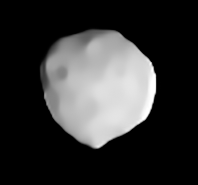Astronomy:324 Bamberga
 VLT image of Bamberga | |
| Discovery | |
|---|---|
| Discovered by | Johann Palisa |
| Discovery date | 25 February 1892 |
| Designations | |
| (324) Bamberga | |
| Pronunciation | /bæmˈbɜːrɡə/ |
| Named after | Bamberg |
| Minor planet category | Main belt |
| Adjectives | Bambergian /bæmˈbɜːrdʒiən, -ɡiən/ |
| Orbital characteristics[1] | |
| Epoch 31 July 2016 (JD 2457600.5) | |
| Uncertainty parameter 0 | |
| Observation arc | 124.08 yr (45321 d) |
| |{{{apsis}}}|helion}} | 3.59442 astronomical unit|AU (537.718 Gm) |
| |{{{apsis}}}|helion}} | 1.77023 AU (264.823 Gm) |
| 2.68232 AU (401.269 Gm) | |
| Eccentricity | 0.34004 |
| Orbital period | 4.39 yr (1604.6 d) |
| Mean anomaly | 225.419° |
| Mean motion | 0° 13m 27.682s / day |
| Inclination | 11.1011° |
| Longitude of ascending node | 327.883° |
| 44.2409° | |
| Physical characteristics | |
| Dimensions | c/a = 0.96±0.05[2] |
| Mean diameter | 227±3 km[2] 234.67 ± 7.80 km[3] 229.4 ± 7.4 km (IRAS)[4] |
| Mean density | 1.67±0.16 g/cm3[2] 1.52±0.20 g/cm3[3] |
| Rotation period | 1.226 d[5] 29.43 h (1.226 d)[1] |
| Geometric albedo | 0.060 (calculated)[2] 0.0628±0.004[4] |
| C-type asteroid[6] | |
| Absolute magnitude (H) | 6.82[1][4] |
Bamberga (minor planet designation: 324 Bamberga) is one of the largest asteroids in the asteroid belt. It was discovered by Johann Palisa on 25 February 1892 in Vienna. It is one of the top-20 largest asteroids in the asteroid belt. Apart from the near-Earth asteroid Eros, it was the last asteroid which is ever easily visible with binoculars to be discovered.
Overall Bamberga is the tenth-brightest main-belt asteroid after, in order, Vesta, Pallas, Ceres, Iris, Hebe, Juno, Melpomene, Eunomia and Flora. Its high eccentricity (for comparison 36% higher than that of Pluto), though, means that at most oppositions other asteroids reach higher magnitudes.
Observation

Although its very high orbital eccentricity means its opposition magnitude varies greatly, at a rare opposition near perihelion Bamberga can reach a magnitude of +8.0,[7] which is as bright as Saturn's moon Titan. Such near-perihelion oppositions occur on a regular cycle every twenty-two years, with the last occurring in 2013 and the next in 2035, when attaining magnitude 8.1 on 13 September. Its brightness at these rare near-perihelion oppositions makes Bamberga the brightest C-type asteroid, roughly one magnitude brighter than 10 Hygiea's maximum brightness of around +9.1. At such an opposition Bamberga can in fact be closer to Earth than any main-belt asteroid with magnitude above +9.5, getting as close as 0.78 AU. For comparison, 7 Iris never comes closer than 0.85 AU and 4 Vesta never closer than 1.13 AU (when it becomes visible to the naked eye in a light pollution-free sky).
Characteristics
The 29-hour rotation period is unusually long for an asteroid more than 150 km in diameter.[8] Its spectral class is intermediate between the C-type and P-type asteroids.[6]
10μ radiometric data collected from Kitt Peak in 1975 gave a diameter estimate of 255 km.[9] An occultation of Bamberga was observed on 8 December 1987, and gave a diameter of about 228 km, in agreement with IRAS results. In 1988 a search for satellites or dust orbiting this asteroid was performed using the UH88 telescope at the Mauna Kea Observatories, but the effort came up empty.[10]
References
- ↑ 1.0 1.1 1.2 "JPL Small-Body Database Browser: 324 Bamberga". https://ssd.jpl.nasa.gov/sbdb.cgi?sstr=324.
- ↑ 2.0 2.1 2.2 2.3 P. Vernazza et al. (2021) VLT/SPHERE imaging survey of the largest main-belt asteroids: Final results and synthesis. Astronomy & Astrophysics 54, A56
- ↑ 3.0 3.1 Carry, B. (December 2012), "Density of asteroids", Planetary and Space Science 73: pp. 98–118, doi:10.1016/j.pss.2012.03.009, Bibcode: 2012P&SS...73...98C. See Table 1.
- ↑ 4.0 4.1 4.2 Tedesco, E.F.; Noah, P.V. (2004). "IRAS Minor Planet Survey. IRAS-A-FPA-3-RDR-IMPS-V6.0.". NASA Planetary Data System. http://www.psi.edu/pds/resource/imps.html.
- ↑ Harris, A. W.; Warner, B.D.; Pravec, P., eds (2006). "Asteroid Lightcurve Derived Data. EAR-A-5-DDR-DERIVED-LIGHTCURVE-V8.0.". NASA Planetary Data System. http://www.psi.edu/pds/resource/lc.html.
- ↑ 6.0 6.1 Neese, C., ed (2005). "Asteroid Taxonomy.EAR-A-5-DDR-TAXONOMY-V5.0.". NASA Planetary Data System. http://www.psi.edu/pds/resource/taxonomy.html.
- ↑ Donald H. Menzel; Jay M. Pasachoff (1983). A Field Guide to the Stars and Planets (2nd ed.). Boston, MA: Houghton Mifflin. p. 391. ISBN 0-395-34835-8. https://archive.org/details/fieldguidetostar00menz_0/page/391.
- ↑ "JPL Small-Body Database Search Engine: diameter > 150 (km) and rot_per > 24 (h)". JPL Solar System Dynamics. http://ssd.jpl.nasa.gov/sbdb_query.cgi?obj_group=all;obj_kind=all;obj_numbered=all;OBJ_field=0;ORB_field=0;combine_mode=AND;c1_group=OBJ;c1_item=Ap;c1_op=%3E;c1_value=150;c2_group=OBJ;c2_item=As;c2_op=%3E;c2_value=24;table_format=HTML;max_rows=50;format_option=comp;c_fields=AcBhBgBjBiBnBsAiApAs;.cgifields=format_option;.cgifields=ast_orbit_class;.cgifields=combine_mode;.cgifields=table_format;.cgifields=obj_kind;.cgifields=obj_group;.cgifields=obj_numbered;.cgifields=com_orbit_class&query=1&c_sort=AsD.
- ↑ Morrison, D.; Chapman, C. R. (March 1976), "Radiometric diameters for an additional 22 asteroids", Astrophysical Journal 204: pp. 934–939, doi:10.1142/9789812834300_0469, Bibcode: 2008mgm..conf.2594S.
- ↑ Gradie, J.; Flynn, L. (March 1988), "A Search for Satellites and Dust Belts Around Asteroids: Negative Results", Abstracts of the Lunar and Planetary Science Conference 19: pp. 405–406, Bibcode: 1988LPI....19..405G.
External links
- 324 Bamberga at AstDyS-2, Asteroids—Dynamic Site
- 324 Bamberga at the JPL Small-Body Database
 |
